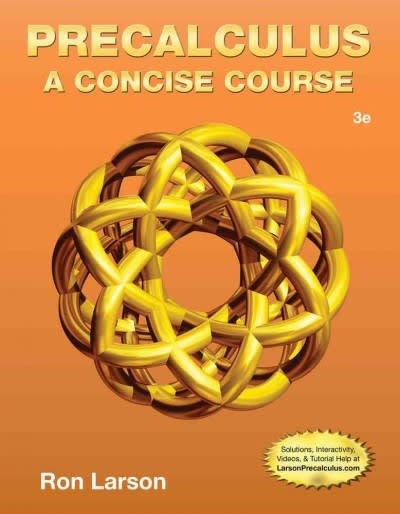Question
1. Suppose again that two new groups of 50 people have been randomly selected and asked their height in centimetres. The two groups are labelled
1. Suppose again that two new groups of 50 people have been randomly selected and asked their height in centimetres. The two groups are labelled "Group A" and "Group B". Further suppose that we wish to test the following hypotheses:
H0:1=2versusH1:12,
where:
- 1 denotes the true average height of people in the Group A population
- 2 denotes the true average height of people in the Group B population.
Using the data collected, an independent samples t-test was carried out with the following results:
Welch Two Sample t-test data: df$Height by df$Group t = -2.8292, df = 72.839, p-value = 0.006025 alternative hypothesis: true difference in means between group Group A and group Group B is not equal to 0 95 percent confidence interval: -6.169655 -1.069773 sample estimates: mean in group Group A mean in group Group B 172.1482 175.7679 Answer the following questions, rounding your answers to three decimal places where relevant. please show explanation.
- What is the test statistic? Answer
- What is the degrees of freedom? Answer
- What is the p-value? Answer
- What is the sample mean for Group A? Answer
- What is the sample mean for Group B? Answer
- What is the LOWER bound of the confidence interval (i.e., the lower number in the confidence interval range)? Answer
- What is the UPPER bound of the confidence interval (i.e., the higher number in the confidence interval range)? Answer
2. Suppose a group of 50 university students participated in a study which aimed to compare alertness levels before and after coffee consumption. In this study, the students were provided with a chart containing nine symbols, each coded with a number from 1 to 9. Then, the students were asked to perform the following coding task: one of the nine symbols, selected at random, appeared to the student, and they needed to correctly code this symbol to its associated number from 1 to 9. The time taken to complete this task was then recorded. Students completed this coding task both before and after coffee consumption. We wish to test the following hypotheses:
H0:D=0versusH1:D0,
where:
- D denotes the true mean difference in time taken to perform the task before coffee consumption compared with after coffee consumption
Using the data collected, it was found that the average time taken to perform the task before coffee was 1.5502 seconds, while the average time taken to perform the task after coffee was 1.4571 seconds, so that the estimated mean difference was 1.4571 - 1.5502 = -0.0931 seconds.
A paired t-test was carried out with the following results:
Paired t-test data: df$reaction.time by df$Group t = -0.85357, df = 49, p-value = 0.3975 alternative hypothesis: true difference in means is not equal to 0 95 percent confidence interval: -0.3122720 0.1260806 sample estimates: mean of the differences -0.09309567 Answer the following questions, rounding your answers to three decimal places where relevant. (Note that a rounding tolerance has been built into the question, so that small discrepancies in mean differences due to rounding have been allowed for.) please show explanation.
- What is the test statistic? Answer
- What is the degrees of freedom? Answer
- What is the p-value? Answer
- What is the sample mean of the difference? Answer
- What is the LOWER bound of the confidence interval (i.e., the lower number in the confidence interval range)? Answer
- What is the UPPER bound of the confidence interval (i.e., the higher number in the confidence interval range)? Answer
Step by Step Solution
There are 3 Steps involved in it
Step: 1

Get Instant Access to Expert-Tailored Solutions
See step-by-step solutions with expert insights and AI powered tools for academic success
Step: 2

Step: 3

Ace Your Homework with AI
Get the answers you need in no time with our AI-driven, step-by-step assistance
Get Started


